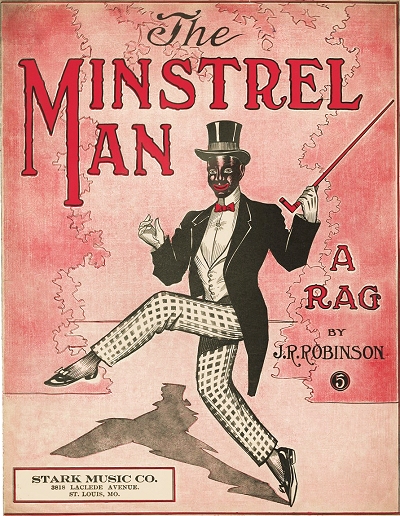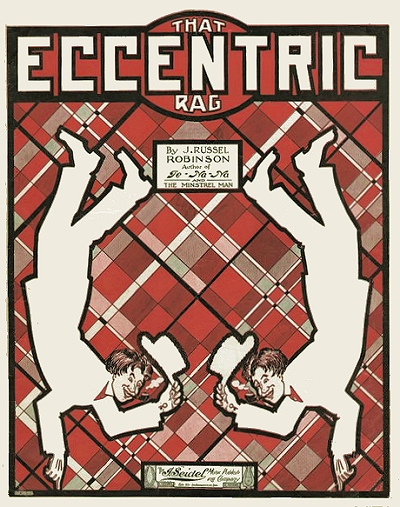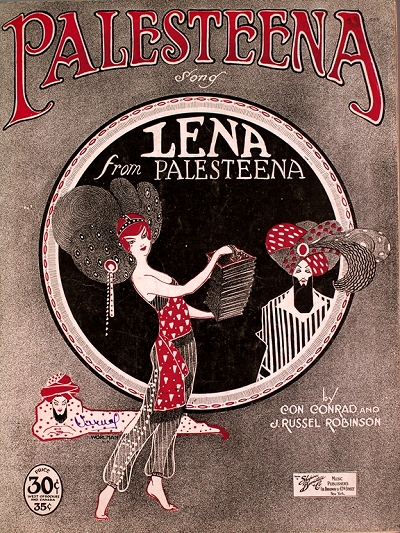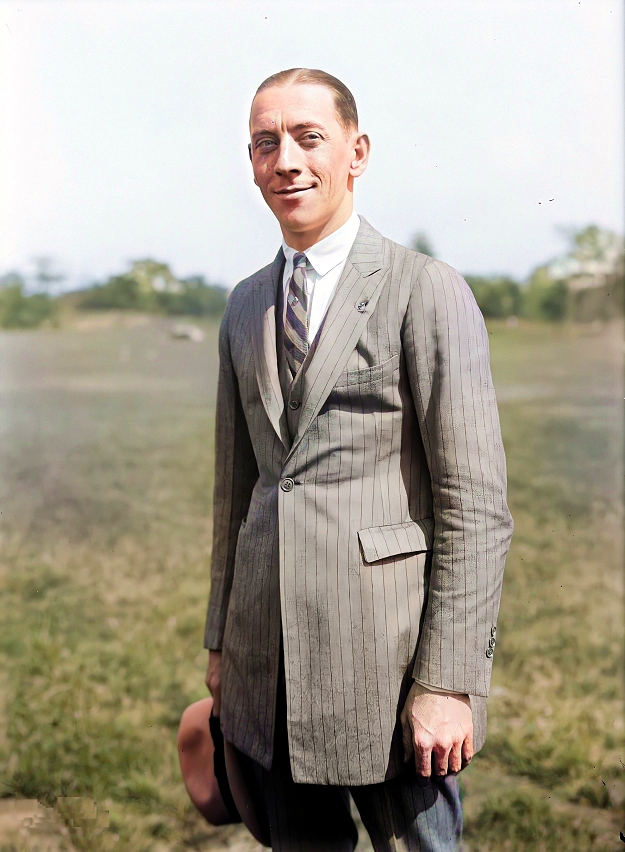J. Russel Robinson represents one of the late entries into the famous Indiana school of ragtime composers, but his influence went far beyond the ragtime era and left a mark on American music. He was also successful in the integration of black and white music forms, sometimes passing as black in his compositions in spite of his being white. Born Joseph Russel in Indianapolis to Marcus (or Marquis) L. Robinson and Elizabeth Eleanor "Lizzie" Hoover, he was brought up in a mixed environment both musically and in his family life. Joseph's older brother John Conrad Robinson (4/30/1891) would also be musically inclined.
As of the 1900 census the family was living on the outskirts of Indianapolis with Marcus working as a mechanical engineer. Joseph is already being referred to as Russel in this record. It seems likely the family stayed in the Indianapolis area through 1909 or so. During his early childhood, Joseph had a bout with polio (stated as infantile paralysis on his draft record) that would have the greatest impact on his right arm. In spite of constant pain when he played, the youth's desire to make music overcame these issues for most of his life.
During his early childhood, Joseph had a bout with polio (stated as infantile paralysis on his draft record) that would have the greatest impact on his right arm. In spite of constant pain when he played, the youth's desire to make music overcame these issues for most of his life.
 During his early childhood, Joseph had a bout with polio (stated as infantile paralysis on his draft record) that would have the greatest impact on his right arm. In spite of constant pain when he played, the youth's desire to make music overcame these issues for most of his life.
During his early childhood, Joseph had a bout with polio (stated as infantile paralysis on his draft record) that would have the greatest impact on his right arm. In spite of constant pain when he played, the youth's desire to make music overcame these issues for most of his life.Robinson had the typical music training in a town full of capable teachers. He attended Shortridge High School in Indianapolis, and some of his first public performances on piano with his brother John at the drums were there. The duo also was able to find jobs playing for a couple of the movie houses on evenings and weekends. A submission of a piece sent to classic rag publisher John Stark resulted in his first rag publication with Sapho Rag. A deliberate misspelling of Sappho, the Greek goddess of poetry, Stark altered the title in order to avoid any direct connection with the alleged lesbian overtones that came with the name. The cover was re-used 12 years later for James Scott's Modesty Rag, but still sold fairly well in its first incarnation. After Joseph, or Russel as he now preferred to call himself, graduated he and his brother traveled with a vaudeville troupe billed as The Famous Robinson Brothers, hoping that the "famous" part would become true, no doubt. It was also at this time in early 1910 that the family relocated for a time to Montgomery Alabama, and Russel brought along his childhood sweetheart, now wife, Marguerite Kendall.
The 1910s were a productive time for Robinson and his family. His second syncopated piece, Dynamite Rag: A Negro Drag, helped gain him a reputation as a rag writer. With Marguerite he penned a comic piece that is still a classic, I Feel Religion Coming On, about how people in tight situations suddenly find religion in an attempt to salvage that situation. Marguerite added lyrics to one more composition under her married name, then keep to her maiden name of Kendall for future submissions, possibly for professional reasons as the couple remained married for more than a decade. By 1912, when Robinson's biggest ragtime hit That Eccentric Rag was published, he was being billed as "The White Boy with the Colored Fingers," more of a non-racist compliment then than it would seem today. With his wife and brother, Russel toured much of the country, primarily the South, spending quite a bit of time in New Orleans and soaking up the local styles there, an influence that would show up in his later works. During his years on the road, largely from 1910 to 1917, his composing output is small, consisting of a couple of rags, assorted waltzes, and songs written with Marguerite. This would change once he became established in New York for a while.
During his years on the road, largely from 1910 to 1917, his composing output is small, consisting of a couple of rags, assorted waltzes, and songs written with Marguerite. This would change once he became established in New York for a while.
 During his years on the road, largely from 1910 to 1917, his composing output is small, consisting of a couple of rags, assorted waltzes, and songs written with Marguerite. This would change once he became established in New York for a while.
During his years on the road, largely from 1910 to 1917, his composing output is small, consisting of a couple of rags, assorted waltzes, and songs written with Marguerite. This would change once he became established in New York for a while.Russel was spared fighting in the war because of his right arm and as support for his wife. In 1917 both he and his brother were back in Indianapolis living at the same address and playing full-time for the Starland Theater. As it was owned by the Meridian Amusement Company it can be assumed this was a movie and perhaps vaudeville house. Somehow, the following year, Russel hooked up with composer/publisher Spencer Williams who composed three blues pieces with him. In short order both Russel and John were employed in Manhattan and were heard frequently in some of the white performance venues in town, and likely in theaters as well. Robinson also caught the attention of the QRS piano roll company in 1918, and he became an occasional staff arranger at large for much of the next decade, cutting some fine rolls of both his pieces and selected works by other composers.
Shortly after the war was over the Spanish Flu Pandemic had its way in the United States, taking out many people including musicians as it swept the country. Among those were composer Felix Arndt and pianist Henry Ragas of the Original Dixieland Jazz Band. So when the sad opportunity through necessity presented itself early in 1919, Robinson was among those who auditioned for the job. He eventually beat out even the legendary ragtime veteran Mike Bernard - perhaps due to his youth being nearly 20 years younger - and became a member of the first recording jazz band. Leader Nick La Rocca immediately set his sights on London, so Russel and Marguerite left in early April for an extended date at the Hippodrome in London. Their hastily obtained passports from late February cite "Fulfill Contracted in Conjunction with Original Dixieland Jazz Band" as the reason for travel. During the trip there were many submissions for publication by Joe, mostly penned with a new lyricist partner, ODJB band singer Al Bernard, Some were intended for the London stage, but often fell flat on British ears. One standout during this period was Jazzola written with Al. M. Kendall (any relation to Marguerite is undetermined, and it is possibly a pseudonym for her). By November, however, the couple was back in New York a bit before the rest of the band, and found in early 1920 living with John and his wife Nell in Manhattan. Russel was listed as a theater musician once again, but Marguerite listed no profession. That same year he joined ASCAP, which had been formed in 1914.

The 1920s would prove to be the most fruitful decade of Robinson's career, starting with two hits, one of them a perennial favorite, in 1920. Hired at some point in the late 1910s as an arranger for the firms of W.C. Handy, he had something to do with an arrangement of Ole Miss Rag by Handy, a 1916 rag that would also be the only piano tune that composer Scott Joplin would make a piano roll of by someone other than himself. Russel's actual role is uncertain, but he has received credit along with Handy's name in many cases. He would later do some touch ups and variations on Handy's St. Louis Blues as well. Interracial compositions were a little more common in the late 1910s than performances, but still rarely found. He also continued to work, on occasions, with the ODJB when they were close by, but that group spent a lot of time on an arduous tour of the United States from 1920 to 1923, so his contributions were sporadic.
Temporarily teamed up with future music hall of fame member Con Conrad in 1920 with Broadway productions in their sights, the duo turned out Lena (From Palesteena), then topped that feat with Margie, likely a nod to Marguerite. The latter song, a reworking of his earlier Lullaby Blues, benefits from simplicity more than almost any other factor. It was easy for the public to remember both the music and lyrics, and became a hit on the stage as well. In addition, Margie was a great commercial success for the ODJB when they recorded it in 1920 along with Robinson's Singin' the Blues and Lena on the same disc. The piece has been regularly performed by jazz bands into the 21st Century, and where That Eccentric Rag would cement his ragtime fame, Margie made him into a true songwriter.
Tragedy struck in 1921 when his life-long love Marguerite died (the cause is difficult to ascertain). He got back on his feet, however, and reinvested himself in composing with a number of partners, occasionally as they lyricist. He was also remarried on October 19, 1921, to Joephine Henning in Bronx, New York. Getting back to work, there was the occasional instrumental, such as Erratic Rag which was a jazzy companion to That Eccentric Rag. Robinson and Bernard would hit their stride in 1924, with Robinson' aggregate output being a new song every couple of weeks. Bernard was a clever lyricist at this time, and titles such as the radio-craze How 'ya' Gonna Make Love/ When She's Tuning In X.Y.Z? and Let Me Be the First to Kiss You Good Morning, and the Last to Kiss You Good Night drew the attention of both sheet music and record consumers.
A couple of years later Russ teamed with Roy Turk for another series of fine pop tunes, including Mary Lou. Both Mary Lou and Margie would spawn Hollywood movies based on those titles in the late 1940s. Another of their big hits was Aggravatin' Papa (Don't You Try to Two-Time Me), introduced in Plantation Revue on Broadway by an all-black cast. While the musical only ran for three weeks in the summer of 1922, the song with its bold cover can still be found in many sheet music collections as it sold very well. Note that musician/publisher Addy Britt is listed here with a question mark on that piece, since his name was not on the original cover nor on the inside plates of the modified cover that does have his name, so his role was likely promotional.
Robinson had not given up playing by any stretch, and in addition to his work in theaters he also accompanied singers on early jazz and blues records both in New York and back in his home state in Richmond, Indiana. What is unusual in this is that he was employed to record with black singers as well as white ones, a practice frowned upon in public, but one that his employers knew would still yield lasting results. Among the singers of both races he played behind were Lucille Hagamin (the second black singer to record after Mamie Smith), Annette Hanshaw, Marion Harris and Lizzie Miles. In many cases, in order to prevent professional issues, he was credited as Spencer Williams as per Williams' explicit permission, a great compliment as well to both of them. Under his own name he also cut a series of discs with Al Bernard singing, most on the Pathé label.
What is unusual in this is that he was employed to record with black singers as well as white ones, a practice frowned upon in public, but one that his employers knew would still yield lasting results. Among the singers of both races he played behind were Lucille Hagamin (the second black singer to record after Mamie Smith), Annette Hanshaw, Marion Harris and Lizzie Miles. In many cases, in order to prevent professional issues, he was credited as Spencer Williams as per Williams' explicit permission, a great compliment as well to both of them. Under his own name he also cut a series of discs with Al Bernard singing, most on the Pathé label.
 What is unusual in this is that he was employed to record with black singers as well as white ones, a practice frowned upon in public, but one that his employers knew would still yield lasting results. Among the singers of both races he played behind were Lucille Hagamin (the second black singer to record after Mamie Smith), Annette Hanshaw, Marion Harris and Lizzie Miles. In many cases, in order to prevent professional issues, he was credited as Spencer Williams as per Williams' explicit permission, a great compliment as well to both of them. Under his own name he also cut a series of discs with Al Bernard singing, most on the Pathé label.
What is unusual in this is that he was employed to record with black singers as well as white ones, a practice frowned upon in public, but one that his employers knew would still yield lasting results. Among the singers of both races he played behind were Lucille Hagamin (the second black singer to record after Mamie Smith), Annette Hanshaw, Marion Harris and Lizzie Miles. In many cases, in order to prevent professional issues, he was credited as Spencer Williams as per Williams' explicit permission, a great compliment as well to both of them. Under his own name he also cut a series of discs with Al Bernard singing, most on the Pathé label.Once back in Indiana in the middle of decade, Russel continued his submissions, but others also came to him for advice and arrangement help, and likely connections. Among them was another Hoosier, future great Hoagy Carmichael, who often submitted pieces by sliding manuscripts under the door of Robinson's home. The location of that home had shifted to Los Angeles, California by 1930, where he was found living with Josephine, working as an independent music composer in the early years of sound movies. However, he would soon marry once again to Gertrude Fitzgerald, and the couple eventually had an only daughter, Theresa. In late 1931 Russel would be back in New York, leasing a home at the corner of Chestnut and State streets in Flushing, and possibly without wife and child. He would soon remarry once more to Mabel Robinson, with whom he would write a piece in 1934.
Lyricists would often seek the composer out to gain successful collaborations, and in the 1930s they included Noble Sissle, who had been estranged from former partner Eubie Blake for several years, and Mercer Cook, who would also co-compose a series of good 1930s pop-tunes with him. One piece made popular in the underground by Cotton Club singer Cab Calloway was the questionable yet clever Reefer Man. Some of Robinson's work was heard on regular radio appearances by the composer, usually in bands or small ensembles but sometimes as a featured artist during a time when radio was driven by live music. His riskiest set of compositions was released by published Joe Davis in 1934. These songs about infamous gangsters John Dillinger, Bonnie Parke and Clyde Barrow, were written using the pseudonym Joe Hoover (his mother's maiden name), in part to take a stab at the mildly obsessive FBI chief J. Edgar Hoover, and in part to protect his own identity in case the gangsters he was parodying found the tunes objectionable. They were ultimately renewed under his actual name. A couple of other songs also appeared under the name Joe Hoover.
A 1936 composition, Less Work for Mother, became the established theme for the Horn and Hardart Children's Hour broadcasts, on which Russel regularly appeared as a performer. Also in 1936, ODJB co-founder Larry Shields organized a revival of the band and Robinson toured with them for a short while. It soon became was evident that the old traditional jazz sound would not succeed in the face of the Swing Era. Eight years later the San Francisco Jazz Revival would provide the necessary catalyst to keep that music alive, but the mid-1930s were still a fickle time, in part because Americans were looking forward to the end of the Great Depression, not back to reminders of it.
As of the 1940 census, Russel, Mabel, and her son Edward, were residing in Queens, New York, with Russel listed as a composer in the song writing industry. By the early 1940s Robinson had taken to the road again. For the required 1942 draft registration he listed his residence in Columbus, Indiana, but his mailing address was in Miami, Florida, a good location for working musicians in the 1940s. He designated his employment as that of composer and traveling musician. In 1947 Russel recorded eight ragtime solos for the Circle Records label of historian Rudi Blesh, the only time that sound recordings had him as the featured artist. Back in Hollywood by the late 1948, he composed a title theme for the movie Portrait of Jennie.
The 1950s found Russel mostly retired and living off his royalties in Palmdale, California, located in the desert just north of Los Angeles. There he formed the J. Russel Robinson Composing Company. Russel was approached in 1957 by Sacramento, California librettist and lyricist Leo McElroy to contribute to a score for his musical Mermaid Tavern, based on part of tales of the famed London location dating back to the time of Shakespeare. While the completed work with some of his pieces in it spent a short time off-Broadway it did not go very far at that time. It has since found success in regional theaters around the country, keeping Robinson's final published work alive. He also did some work with bandleader Sammy Kaye.
In 1963 J. Russel Robinson died at age 71 after a brief bout with complications from lung cancer, the result of a life-long smoking habit. In his obituary, it was Gertrude who was referenced as his widow, along with their married daughter, now Theresa Duffie. It is unclear if they had got back together at some point. Although gone, his name is still very much alive and embedded in American music culture, and indeed is known around the world.

 Compositions
Compositions